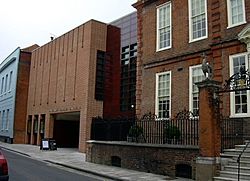Pallant House Gallery facts for kids

The gallery extension, with Pallant House on the right
|
|
| Lua error in Module:Location_map at line 420: attempt to index field 'wikibase' (a nil value). | |
| Established | 1982 |
|---|---|
| Location | North Pallant, Chichester, West Sussex |
| Type | Art Gallery |
| Architect | Colin St John Wilson, MJ Long |
Pallant House Gallery is a special art gallery located in Chichester, West Sussex, England. It holds one of the best collections of British art from the 1900s. Imagine seeing amazing paintings and sculptures all in one place!
Contents
What is the History of Pallant House Gallery?
How the Collection Started
The gallery's art collection began with a generous gift from Walter Hussey in 1977. He was the Dean of Chichester Cathedral and loved art. When he retired, he gave many artworks to the city of Chichester. These included pieces by famous artists like Barbara Hepworth, Henry Moore, John Piper, Ceri Richards, and Graham Sutherland. Mr. Hussey had one important rule: his collection had to be shown in Pallant House itself.
More Amazing Gifts of Art
Over the years, other people also donated their art collections to the gallery.
- In 1989, a property developer named Charles Kearley gave works by British artists such as John Piper and Ben Nicholson. He also donated art by European masters like Paul Cézanne, André Derain, Fernand Léger, and Gino Severini.
- In 2006, the architect Colin St John Wilson added to the collection. He donated works by artists like Michael Andrews, Peter Blake, Lucian Freud, and Richard Hamilton. Many of these artists were friends with Sir Colin, and he even designed homes for some of them!
- More recently, in 2018, Frank and Lorna Dunphy gave six artworks by a group called the Young British Artists. One of these was a piece called Butterfly by the well-known artist Damien Hirst.
A Collection That Moved On
The gallery once had a wonderful collection of 18th-century Bow porcelain. This was a gift from Geoffrey Freeman. However, in 2020, this collection was moved to the Holburne Museum in Bath. This was done to help the Pallant House Gallery focus on its main collection of 20th-century British art.
What Art Can You See at the Gallery?
The main focus of Pallant House Gallery is British art from the 1900s. You can see paintings, sculptures, and other artworks that show how art changed and grew during that time. Many of the pieces were given by people who truly loved art and wanted to share it with everyone.
The gallery also displays art that is on "long-term loan." This means the artworks are borrowed for a long time, and sometimes they are later given to the gallery permanently.
What Exhibitions Does the Gallery Host?
Pallant House Gallery often has special exhibitions that focus on specific artists or themes. These temporary shows allow visitors to see different kinds of art.
- From October 2015 to February 2016, the gallery showed Evelyn Dunbar: The Lost Works. This exhibition featured 500 paintings by Evelyn Dunbar that had been missing for a long time and were found in 2013. This discovery actually doubled the number of her known artworks!
- In 2016, there was an exhibition called John Piper: The Fabric of Modernism. This show highlighted John Piper's designs for textiles, like fabrics.
- In 2021, the gallery presented Glyn Philpot: Flesh and Spirit. This was the first big exhibition of Glyn Philpot's work since 1984.
- Other past exhibitions have featured artists like Gwen John (2023), Hockney to Himid (2021-2022), and David Remfry (2015).
What is Pallant House Like?
Pallant House itself is a very old and beautiful building. It's a Grade I listed Queen Anne townhouse built in 1712. It was originally built for a wine merchant named Henry Peckham.
The Historic House
The house is made of lovely bricks and has large windows. Look closely at the entrance, and you'll see stone ostriches guarding it! These ostriches are from the Peckham family's coat of arms. Inside, there's a beautiful oak staircase. The design of the house was so special that it even caused a legal case back in the day!
For many years, starting in 1919, the building was used as council offices. It was carefully restored in 1979, and the art gallery officially opened its doors in 1982. Since 1985, an independent group has managed the gallery.
The Modern Extension
In June 2006, a brand new part of the gallery opened. This modern extension was designed by Sir Colin Wilson and Long & Kentish. The project cost about £8.6 million and was supported by various groups, including the Heritage Lottery Fund.
This new part of the gallery stands right next to the old Queen Anne house. The way the old and new buildings connect creates a really interesting look. Judges for the 2007 Gulbenkian Prize said that this mix creates "a vibrant relationship between old and new." The extension also won an award from the RIBA in 2007.
Eco-Friendly Heating
Pallant House Gallery is believed to be the first art gallery in the UK to use a special geothermal system for heating and cooling. This system uses water pumped through pipes deep under the building. It helps to cut the gallery's carbon emissions by about half, making it more environmentally friendly!
Behind the gallery, there's also a lovely new courtyard garden. It was designed by Christopher Bradley-Hole, who has won awards at the Chelsea Flower Show.

